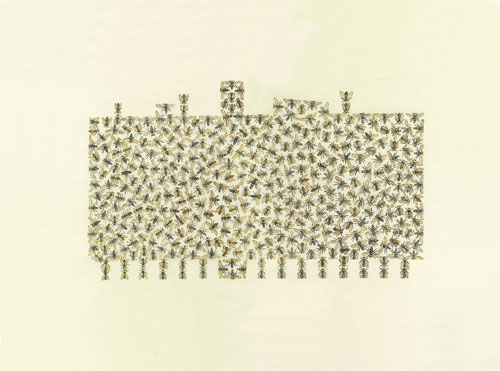TIXIER – POLARIS
Formes collectives
Opening Saturday April 22 in the presence of the artist
Val Fourré, Chêne Pointu, Noyer Renard, Chantepie…, these names that refer to fauna and flora or evoke pastoral landscapes, are actually the names of a number of large housing project, assemblies of blocks and towers gathering a minimum of ’800 housings, that is 4 000 individuals — according to the philosopher Thierry Paquot—, built between 1955 and 1975.
These toponyms with a bucolic sound symbolize the ills of contemporary cities and focus on their social issues. Most often, the estates are no more referred to by their actual names but are qualified as: sensitive neighbourhoods, suburbs, urban priority zone, no go zone…
Inspired by a residency at the Val Fourré (Mantes-la-Jolie*), projects at Noyer Renard (Athis-Mons*) and Grand Vaux (Savigny-sur-Orge*), reviving memories of her childhood at Fontaine du Bac (Clermont-Ferrand), Laure Tixier tells the short history of these projects: originally rural landscapes, they were meant to glorify the idea of modernity and all they became is nothing but modern ghettos.
In the light of bees’ modus vivendi, Tixier studies how we decide (or how one decides for us) to live together, via which processes, through which systems, in what form and through which relationship with the landscape.
Formes collectives’ topics are illustrated by watercolours, ceramics, installation, video; as many oxymorons opposing modernity (and its disqualification) and the preciosity/the meticulous use of these materials.
The three watercolours of the series Les essaims (The swarms), are about the distance covered between modernist pre-World II collective housing (more specifically social housing), and further gigantic housing estates. Seen from a distance, what seem to be geometric shapes become, when you get closer, vibrant clouds made of millions of bees.
These swarms have successively taken the form of Henri Sauvage’s Immeuble des Amiraux (Paris, 1922), of Le Corbusier’s Cité Radieuse (Marseille, 1952), and one of Raymond Lopez’ Tours Degas at the Val Fourré (Mantes-la-Jolie, 1972).
Les ruchers (The apiaries) made of model beehives of the three buildings stand next to The swarms. Made of wood with standard frames, the mock-up of the Tour Degas, destroyed in 2006 by implosion, is habitable by bees. Those potential workers come after the Renault factories workers for whom one of France’s biggest housing projects was designed and built.
Laure Tixier’s work with inhabitants of the estates, started in 2014 with the series of embroideries Radar au fil du temps (presented in 2016 in the exhibition « Unravelled » at the Beirut Art Center), gave her the opportunity to highlight their trauma and relief that were the destruction of the towers ten years earlier during the urban renovation. Entire parts of private lives were pulverised in a few seconds and broadcasted live on TV.
Further, two earthenware beehives are a reminder of the early days of apiculture, when a human being caught a swarm of bees and slid it into an earthenware. Here, the earthenware is no longer egg-shaped but makes use of the vocabulary of housing estates projects: the tower and the block, a vertical rectangle and a horizontal one.
*Located on the outskirts of Paris
